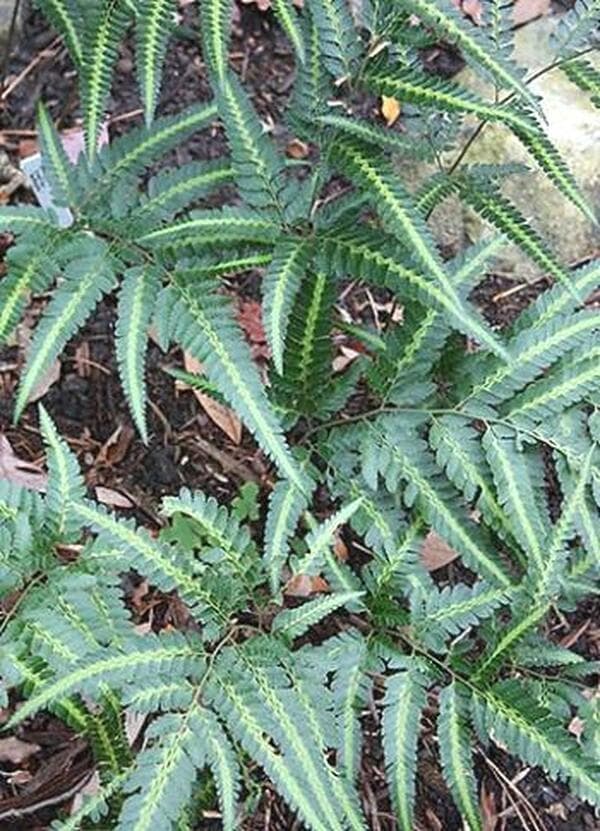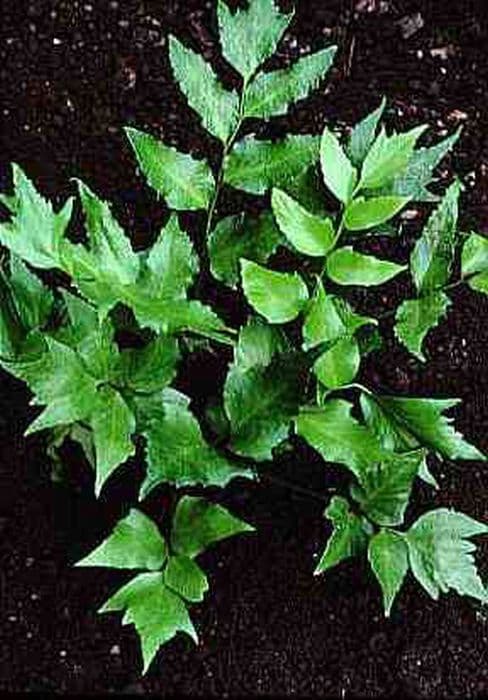Fortune's Holly Fern Cyrtomium fortunei

ABOUT
The Fortune's holly fern is a lush, evergreen fern with a somewhat upright and arching growth habit. The leaves of this plant, often referred to as fronds, have a glossy, leathery texture that is deep green in color, contributing to the plant's robust and vibrant appearance. These fronds are uniquely shaped; they are divided into leaflets that line up on either side of a central stem, much like the feathers of an arrow. Each leaflet has margins that can be subtly serrated or have a gentle wave to them, giving them a delicate and intricate profile. The overall shape of the fronds is somewhat lance-like, tapering to a point at each end. As they mature, the sori – spore-producing structures that are often used to identify ferns – may become visible on the underside of the leaflets, appearing like small dots or clusters. These reproductive structures are typically covered by a protective tissue that might have a different texture and color from the leaflet surface, sometimes adding a touch of contrast to the underbelly of the fronds. The Fortune's holly fern displays a simplicity in its appearance that encapsulates the elegance often associated with ferns, making it a popular choice for shaded gardens and as an ornamental houseplant.
About this plant
 Names
NamesFamily
Dryopteridaceae
Synonyms
Fortune's Holly Fern, Holly Fern
Common names
Aspidium fortunei, Cyrtomium falcatum var. fortunei, Phanerophlebia fortunei.
 Toxicity
ToxicityTo humans
Cyrtomium fortunei, commonly known as Holly Fern, is not considered highly toxic to humans. However, it is always advisable to avoid eating this or any plant that is not known to be edible as it may cause irritation or an upset stomach if ingested. If accidental consumption occurs, monitor for symptoms of gastrointestinal discomfort, and seek medical advice if symptoms persist or worsen.
To pets
Holly Fern, for pets, is similar to its toxicity in humans. It is not recognized as a highly toxic plant to cats and dogs. Although not commonly associated with severe poisoning, ingestion of Holly Fern may lead to mild gastrointestinal upset in pets such as vomiting or diarrhea. If your pet consumes this plant and exhibits these or any other unusual symptoms, it is recommended to contact a veterinarian to ensure proper care.
 Characteristics
CharacteristicsLife cycle
Perennials
Foliage type
Evergreen
Color of leaves
Green
Height
2 feet (60 cm)
Spread
2 feet (60 cm)
Plant type
Fern
Hardiness zones
6
Native area
Asia
Benefits
 General Benefits
General Benefits- Easy to care for: Cyrtomium fortunei, commonly known as Fortune's Holly Fern, is a low-maintenance plant suitable for gardeners of all skill levels.
- Drought resistant: Once established, it can tolerate periods of dryness, making it suitable for xeriscaping and reducing the need for frequent watering.
- Shade tolerant: It thrives in shaded areas where other plants might struggle to grow, making it ideal for understory plantings and shaded gardens.
- Cold hardy: Fortune's Holly Fern is resistant to cold temperatures, which allows it to be grown in a variety of climates.
- Erosion control: Its root system can help stabilize soil on slopes and prevent erosion.
- Evergreen: It retains its foliage year-round, providing consistent greenery and visual interest even during the cooler months.
- Deer and rabbit resistant: The plant is not typically favored by deer or rabbits, making it an excellent choice for gardens troubled by these animals.
 Medical Properties
Medical Properties- This plant is not used for medical purposes.
 Air-purifying Qualities
Air-purifying QualitiesThis plant is not specifically known for air purifying qualities.
 Other Uses
Other Uses- The leaves of the Holly Fern can be used in floral arrangements for a touch of lush greenery and unique textures.
- Holly Ferns can be planted in shady outdoor garden nooks, where many other plants struggle to grow, to create a vibrant green space.
- They serve as a shelter for small wildlife like frogs and beneficial insects, providing them with a damp and cool environment.
- Dried fronds of the Holly Fern can be used in arts and crafts to create nature-inspired motifs and decorations.
- When grown in containers, Holly Fern can be used as a natural screen or divider for privacy in patio or balcony spaces.
- The Holly Fern can be used in educational settings, such as schools or nature centers, to teach children about plant biology and different plant species.
- Due to their texture and durability, Holly Fern leaves can be incorporated into fashion designs, such as sustainable textile prints or patterns.
- The resilience of the Holly Fern allows it to be used in rehabilitation projects for degraded lands where it can help prevent soil erosion.
- They can be incorporated into green roofs or living walls to contribute to the biodiversity and aesthetics of urban structures.
- Gardeners might use the Holly Fern to underplant trees and shrubs, creating a more layered and diverse garden design.
Interesting Facts
 Feng Shui
Feng ShuiThe plant Cyrtomium fortunei, commonly known as Holly Fern, is not specifically used in Feng Shui practice.
 Zodiac Sign Compitability
Zodiac Sign CompitabilityThe Holly Fern is not used in astrology practice.
 Plant Symbolism
Plant Symbolism- Resilience: Cyrtomium fortunei, commonly known as Fortune's Holly Fern, has the ability to thrive in various soil conditions and shaded environments, representing the ability to endure and prosper through hardships.
- Protection: With its holly-like leaves, the Fortune's Holly Fern is reminiscent of the holly plant which is traditionally seen as a symbol of protection, warding off negative energies and ensuring safety.
- Longevity: The lush, evergreen nature of this fern suggests a long life and can be associated with the wish for a lengthy and healthy existence.
- Good Fortune: Given its name, the fern is often linked to luck and prosperity, invoking blessings and positive outcomes for those who grow or gift it.
 Water
WaterThe plant commonly known as Holly Fern (Cyrtomium fortunei) prefers consistent moisture, so watering thoroughly when the top inch of soil feels dry is crucial. Typically, this could mean watering with approximately 16 ounces of water every week, but this can vary based on environmental conditions such as temperature and humidity. It is better to water the plant deeply and less frequently to encourage strong root growth rather than little and often, which can lead to shallow roots. During the winter months, reduce watering slightly as the plant's growth slows down. Always check the soil moisture level before watering to avoid overwatering, which can cause root rot.
 Light
LightHolly Fern (Cyrtomium fortunei) thrives in partial to full shade and should be placed in a spot that receives dappled sunlight or indirect light. It should be protected from direct, harsh sunlight, particularly during the hot afternoon hours, to prevent the leaves from scorching. A north-facing windowsill or a shaded area of a bright room makes an ideal location for this fern.
 Temperature
TemperatureHolly Fern (Cyrtomium fortunei) grows best in temperatures between 60°F and 70°F. It can tolerate a minimum temperature of 50°F, making it a suitable houseplant for most indoor environments. However, it should be protected from drastic temperature changes and kept away from drafty windows and vents.
 Pruning
PruningPruning Holly Fern (Cyrtomium fortunei) isn't often necessary, but it can be done to remove dead or damaged fronds to maintain the plant's appearance and health. The best time for pruning is in the spring when new growth begins. Cutting back the old fronds at this time will encourage fresh, new foliage to emerge. Pruning should be done sparingly as these ferns do not regrow quickly.
 Cleaning
CleaningAs needed
 Soil
SoilHolly Fern prefers a well-draining soil mix comprised of one part garden soil, one part peat, and one part perlite or sand to ensure proper drainage and aeration. The ideal soil pH for Holly Fern should be slightly acidic to neutral, ranging from 6.0 to 7.0.
 Repotting
RepottingHolly Fern does not require frequent repotting; it can be repotted every 2 to 3 years or when it outgrows its current pot. Ensure to use a pot that is slightly larger than the previous one and provide fresh soil mix while repotting.
 Humidity & Misting
Humidity & MistingHolly Fern thrives best in moderate to high humidity levels. Maintaining indoor humidity around 40-50% is ideal for the healthy growth of this fern.
 Suitable locations
Suitable locationsIndoor
Place Holly Fern in bright, indirect light; maintain moisture.
Outdoor
Grow Holly Fern in shaded areas with moist soil.
Hardiness zone
5-10 USDA
 Life cycle
Life cycleCyrtomium fortunei, commonly known as Fortune's holly fern, begins its life cycle as a spore, which germinates in moist conditions to form a prothallus. The prothallus, a small, heart-shaped gametophyte, develops both male (antheridia) and female (archegonia) reproductive organs. Through water-facilitated fertilization, sperm from the antheridia swim to the archegonia to fertilize the egg, leading to the development of a sporophyte. The sporophyte emerges as a young fern, establishing roots and uncurling fronds in a process called 'fiddleheading' or circinate vernation. The mature fern develops sori, clusters of sporangia, on the underside of its fronds, which release new spores to continue the cycle. Throughout its life, Fortune's holly fern grows in shady habitats, often forming dense clumps, and may live several years, with each individual frond typically lasting one to several growing seasons before dying back as new fronds emerge.
 Propogation
PropogationPropogation time
Spring-Early Summer
The most popular method of propagation for Cyrtomium fortunei, commonly known as Fortune's holly fern, is by division. This is typically done in the spring when the plant's growth begins to resume. To propagate by division, the root ball of an established plant is carefully removed from the soil and gently separated into smaller sections, ensuring that each section has a portion of the root system and several fronds. These sections are then planted in potting mix at the same depth they were originally growing, watered thoroughly, and kept in a shaded area until they establish. This method allows gardeners to quickly increase their stock while maintaining the characteristics of the parent plant.









